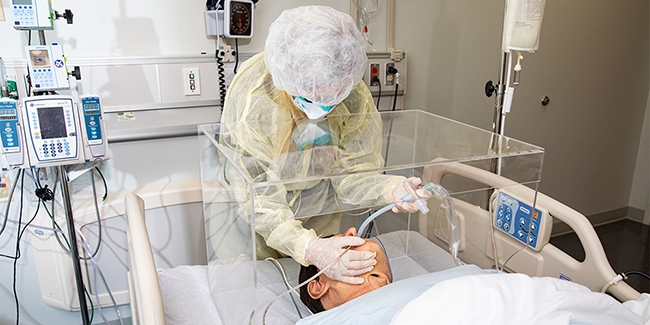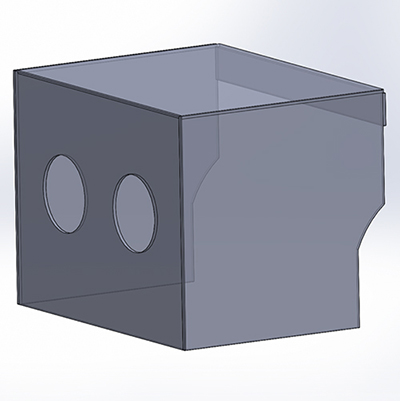Researchers Customize 'Aerosol Boxes' for Washington Regional

Morten Jensen, associate professor of biomedical engineering, partnered with Dr. Drew Rodgers, cardiothoracic anesthesiologist at Washington Regional Medical Center, to produce transparent acrylic boxes that clinicians can use during the intubation process, seen here during a practice run with a manikin, to reduce the spread of COVID-19 within the hospital setting.
FAYETTEVILLE, Ark. – Aerosol boxes, as reported April 3 in the New England Journal of Medicine, have emerged organically as an innovative solution to protect clinicians from exposure during the critical procedure of intubating patients with COVID-19.
To address this problem locally, Morten Jensen, associate professor of biomedical engineering, has partnered with Dr. Drew Rodgers, cardiothoracic anesthesiologist at Washington Regional Medical Center, to produce transparent acrylic boxes that clinicians can place over a patient's head and neck while intubating, which is the process of inserting a tube through a patient's mouth and into the airway leading to the lungs. Intubation is done so a patient can be placed on a ventilator to assist with breathing.
In addition to an opening for the patient's head, aerosol boxes have portals through which clinicians can extend their arms to work on the patient. The boxes provide an extra layer of protection in addition to personal protective equipment used during procedures such as mask ventilation and endotracheal intubation. Aerosol boxes can be quickly sterilized with bleach or alcohol after each use, so they can be reused.
The team expects to produce 25 boxes for Washington Regional and then looks toward working with other hospitals to address their needs for potential COVID-19 patients.
"This is a clear example of how the intersection of medicine and engineering can quickly come together and help us save lives," Rodgers said. Rodgers contacted Jensen because he knew members of the Cardiovascular Biomechanics Laboratory had extensive experience with making clear, acrylic boxes for holding fluids. After making small design improvements to fit requirements from Washington Regional, Jensen's team partnered with the Fay Jones School of Architecture and Design. Dean Peter MacKeith provided access to machinery and materials that could significantly increase production. The first aerosol box was ready days after Jensen and Rodgers first discussed the concept and partnership.
"These boxes are not for sale anywhere, and we work with these materials and designs all the time," Jensen said. "There's an immediate need to protect staff during these critical, lifesaving procedures. We can make these right away, and they can put them to use immediately."
 The machining and manufacturing of the first aerosol boxes were performed by Angela Carpenter in the Fay Jones School and Sam Stephens in the Department of Biomedical Engineering.
The machining and manufacturing of the first aerosol boxes were performed by Angela Carpenter in the Fay Jones School and Sam Stephens in the Department of Biomedical Engineering.
"This is a great example of what we can do for our community," said Raj Rao, professor and head of the Department of Biomedical Engineering.
Rao, Jensen, MacKeith and others are helping the university work on other critical COVID-19-related projects with hospitals in Arkansas.
Jensen is an Arkansas Research Alliance Scholar. Rao is the George M. and Boyce W. Billingsley Endowed Chair in Engineering.
About the University of Arkansas: The University of Arkansas provides an internationally competitive education for undergraduate and graduate students in more than 200 academic programs. The university contributes new knowledge, economic development, basic and applied research, and creative activity while also providing service to academic and professional disciplines. The Carnegie Foundation classifies the University of Arkansas among fewer than 2.7 percent of universities in America that have the highest level of research activity. U.S. News & World Report ranks the University of Arkansas among its top American public research universities. Founded in 1871, the University of Arkansas comprises 10 colleges and schools and maintains a low student-to-faculty ratio that promotes personal attention and close mentoring.
Topics
Contacts
Matt McGowan, science and research communications officer
University Relations
479-575-4246,
dmcgowa@uark.edu
Headlines
PetSmart CEO J.K. Symancyk to Speak at Walton College Commencement
J.K. Symancyk is an alumnus of the Sam M. Walton College of Business and serves on the Dean’s Executive Advisory Board.
Faulkner Center, Arkansas PBS Partner to Screen Documentary 'Gospel'
The Faulkner Performing Arts Center will host a screening of Gospel, a documentary exploring the origin of Black spirituality through sermon and song, in partnership with Arkansas PBS at 7:30 p.m. Thursday, May 2.
UAPD Officers Mills and Edwards Honored With New Roles
Veterans of the U of A Police Department, Matt Mills has been promoted to assistant chief, and Crandall Edwards has been promoted to administrative captain.
Community Design Center's Greenway Urbanism Project Wins LIV Hospitality Design Award
"Greenway Urbanism" is one of six urban strategies proposed under the Framework Plan for Cherokee Village, a project that received funding through an Our Town grant from the National Endowment for the Arts.
Spring Bike Drive Refurbishes Old Bikes for New Students
All donated bikes will be given to Pedal It Forward, a local nonprofit that will refurbish your bike and return it to the U of A campus to be gifted to a student in need. Hundreds of students have already benefited.




